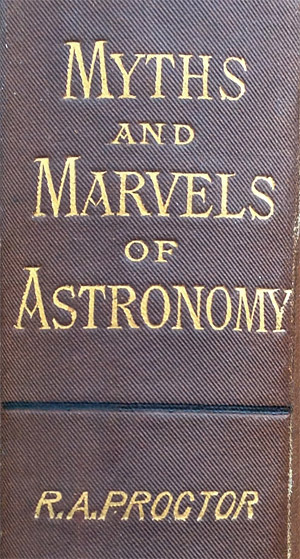If my explorations of skeptical history have revealed an overall theme, it is that things don’t change that much. Always there are scoundrels, scams, and misapprehensions; always there are those who probe mysteries and push back against paranormal fraud. Throughout history, those skeptics have repeatedly reached for the same tactics, claimed the same (scant few) rewards, and faced the same challenges of burnout and cynicism.

Astronomer Richard Anthony Proctor. For general details about Proctor’s life and career, read this brief biographical sketch published in 1874.
English astronomer and science popularizer Richard Anthony Proctor (1837–1888) makes an interesting case study. He weighed in as a skeptic against (surprisingly popular) Flat Earth advocates (see Junior Skeptic 53), quackery, and a range of pseudoscientific ideas connected to astronomy. His debunking book Myths and Marvels of Astronomy was a 19th century version of Phil Plait’s Bad Astronomy. Originally published in 1877 (my copy dates to 1880), Myths and Marvels of Astronomy is available to read for free in several editions online.
Like some other skeptics, Proctor seems to have been both fascinated and repelled by the arguments of “paradoxists” (or “paradoxers”) as pseudoscience proponents were then called. He spent considerable effort on critiques of Flat Earth advocacy—”Zetetic Astronomy,” as that religiously-motivated 19th century pseudoscience movement dubbed itself—yet advised other skeptics not to follow his example, for Flat Earth proponents were “merely types of a class which will always exist.” So what if pseudoscientific baloney confuses ignorant laypeople, he grumbled: “It serves them right for leaving the subject unstudied.”1 His commentary sounds uncomfortably pulled in opposing directions. “As to the Flat-Earth nonsense, that is not and never has been worth the trouble of crushing,” he declared 14 years later—while attempting yet again to combat the chief proponent of that nonsense.2
 His distaste for such debates was not unfounded. One problem, as familiar then as it is today, was that skepticism invited a “shower of abuse.”3 Flaming was inevitable even when critiques were mild, for paradoxists are “well practised in abuse, and have long learned to call mathematicians and astronomers cheats and charlatans.”4 And criticism rarely seemed to work, anyway. “Reasoning has been tried in vain…ridicule is ineffective, and a bad example; denunciation is idle,” he sighed.5
His distaste for such debates was not unfounded. One problem, as familiar then as it is today, was that skepticism invited a “shower of abuse.”3 Flaming was inevitable even when critiques were mild, for paradoxists are “well practised in abuse, and have long learned to call mathematicians and astronomers cheats and charlatans.”4 And criticism rarely seemed to work, anyway. “Reasoning has been tried in vain…ridicule is ineffective, and a bad example; denunciation is idle,” he sighed.5
But despite his cynicism, Proctor couldn’t quite leave nonsense alone. For one thing, it was interesting. And infuriating. And sad. “There is something melancholy even in what is most ridiculous in cases of this sort,” he reflected.6 Sure, it’s comical when someone who clearly knows nothing about physics or astronomy fiercely declares his intuitions to be superior to the expert work “not of Newton only, but of all who have followed in the same track during two centuries”—but those forlorn paradoxists were also people. They’re annoying, yes, and full of themselves. “Yet, when one considers the probable consequences of the blunder to the unhappy enthusiast, and perchance to his family, it is difficult not to feel a sense of pity,” Proctor admitted.7
For science popularizers, he knew, “scientific hoaxes have their uses, just as paradoxical works have.”8 Pseudoscience “is worth examining,” for it “shows what absurdity men can believe,” Proctor felt (citing sentiments expressed by another skeptic, Augustus De Morgan).9 Such preposterous beliefs served as “gauges of general knowledge”10—and revealed that general scientific knowledge was shockingly bad, even among educated professionals.
An example he had in mind was the “so-called ‘lunar hoax'” of 1835, which is the topic of my brand new story for Junior Skeptic 56 (inside Skeptic Vol. 20 No. 3). In this astonishing media hoax case, the popular New York Sun newspaper announced the discovery of life on the Moon—and not just any life, either. The Moon was described as a lush Edenic paradise, home to unicorns, sentient bipedal beavers, and winged bat-people! Over several days, the multi-part Sun article was a widely believed (and wildly profitable) sensation—giving it a place in skeptical history as unquestionably one of the most successful media hoaxes of all time. For the full story, see Junior Skeptic, but for now I will leave you with Proctor’s thoughts. Writing decades later, he used the case to illustrate the public’s acute vulnerability to intentional pseudoscientific deceptions, and to emphasize the awkward truth that scientists are ill-equipped to confront such nonsense. And, he raised a concern that skeptics uneasily ask even today: to what extent is it even possible to change entrenched beliefs? Proctor wrote,
No one, certainly no student of science, can thoroughly understand how little some persons know about science, until he has observed how much will be believed, if only published with the apparent authority of a few known names, and announced with a sufficient parade of technical verbiage; nor is it so easy as might be thought, even for those who are acquainted with the facts, to disprove either a hoax or a paradox. Nothing, indeed, can much more thoroughly perplex and confound a student of science than to be asked to prove, for example, that the earth is not flat, or the moon not inhabited by creatures like ourselves; for the circumstance that such a question is asked implies ignorance so thorough of the very facts on which the proof must be based, as to render argument all but hopeless from the outset. I have had a somewhat wide experience of paradoxists, and have noted the experience of De Morgan and others who, like him, have tried to convince them of their folly. The conclusion at which I have arrived is, that to make a rope of sand were an easy task compared with the attempt to instil the simpler facts of science into paradoxical heads.11
References
- Richard Anthony Proctor. Letter to the Editor. The English Mechanic and Mirror of Science. May 6, 1870. p. 159
- Richard Anthony Proctor. Knowledge, May 2, 1884. p. 313
- Richard Anthony Proctor. Myths and Marvels of Astronomy. (London: Chatto & Windus, 1880.) p. 268
- Ibid.
- Richard Anthony Proctor. Knowledge. March 30, 1883. p. 198
- Proctor. (1880.) p. 272
- Ibid.
- Ibid. p. 263
- Proctor. (1883)
- Proctor. (1880.) p. 263
- Ibid. [Emphasis added.]











